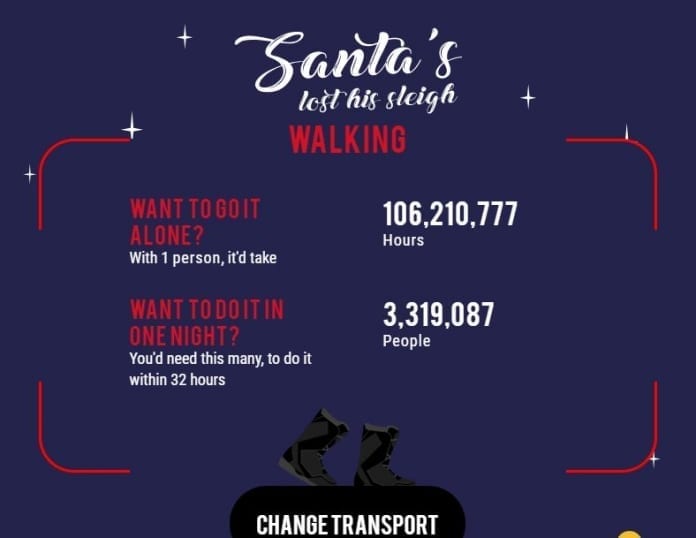- Santa’s sleigh needs to travel at over 13 million mph to deliver the world’s presents in one night
- It would take over 12,000 years to deliver the presents on foot
- To reach every house in one night, it would take nearly 200,000 cars
It’s a good job Santa has his magic sleigh, because if he was to rely on normal methods of transport, children around the world would be left present-less for an awfully long time.
New research from TeamSport Karting, the UK’s largest indoor karting operator, has calculated the sluggish delivery times of each everyday mode of transport were Santa to trade in his vehicle for a non-festive alternative.
With 2.2 billion children across the planet[1], spread between 916 million houses, Father Christmas has to travel a mammoth 424,843,108 miles to deliver gifts each year. This means his sleigh travels at over 13 million mph – more than 17,000 times the speed of sound.
To cover this distance and deliver the world’s presents by car, it was revealed that it would take a staggering 693 years, assuming Santa abided by the UK’s maximum speed limit of 70mph.
To speed up his delivery time he could go by plane, but despite a Boeing 747 cruising at a nifty 550mph, it would still take a miserable 88 years to get to every child’s house. Space rockets travel considerably quicker than commercial aircraft, but even if Santa was to commandeer a NASA shuttle, he’d still be flying for two years and nine months.
If he was concerned about the environmental impact of covering such colossal distances, Father Christmas could opt for greener modes of transport, such as cycling or walking. Such a moral standpoint would, however, sacrifice any hope of children receiving their presents this millennium.
Completing the delivery route by bike would take a slovenly 2,109 years, but if Santa was to walk, he would be delivering presents for a feet-busting 12,125 years.
Such massive delays would clearly not go down very well with the world’s youngest generations, who wake up on Christmas morning expecting to see the latest toys and gizmos under their tree. The research therefore also calculated how many of each mode of transport it would take to deliver all of the presents in Santa’s usual shift – a single night.
If Santa was determined to hit his delivery deadlines by foot in just one night, the manpower required takes on a whole new level. More than three million walkers would be needed to get presents to all of the world’s children on time, which is roughly the population of Wales[2].
To accomplish such a feat using cars, Santa would need a fleet of 189,662 vehicles, while it would take nearly 25,000 planes to do the same by air.
Forgetting the logistics of such an operation, over 750 space rockets would be needed to complete the deliveries in one evening, which is more than eight times the number of spacecraft launched in the whole of 2017[3].
Dominic Gaynor, Managing Director of TeamSport Indoor Karting, said: “Our research highlights just what an amazing job Santa and his reindeer do to ensure every child receives their presents on Christmas morning.
“Our normal methods of transport simply can’t compare to the speed of his sleigh – it would take our 40mph go-karts over 1,000 years to deliver the world’s presents!
“While all of our 31 UK tracks are fully stocked with quality go-karts, unfortunately we don’t quite have the numbers to supply Santa with the 331,909 karts needed to deliver all of the gifts in one night!”
To find out how long it would take you to deliver the world’s Christmas presents, and to learn more about this research, visit: https://www.team-sport.co.uk/teamsport-santa-sums/index.html
Help keep news FREE for our readers
Supporting your local community newspaper/online news outlet is crucial now more than ever. If you believe in independent journalism, then consider making a valuable contribution by making a one-time or monthly donation. We operate in rural areas where providing unbiased news can be challenging. Read More About Supporting The West Wales Chronicle





















